|
DESVAR |

|

|

|

|
|
|
DESVAR |

|

|

|

|
DESVAR
Bulk Data Entry
DESVAR – Design Variable
Description
Defines a design variable.
Format
(1) |
(2) |
(3) |
(4) |
(5) |
(6) |
(7) |
(8) |
(9) |
(10) |
DESVAR |
ID |
LABEL |
XINIT |
XLB |
XUB |
DELXV |
DDVAL |
|
|
+ |
RAND |
ITYPE |
P1 |
P2 |
P3 |
|
|
|
|
+ |
RANP |
ITYPE |
P1 |
P2 |
P3 |
|
|
|
|
|
Field |
Contents |
ID |
Unique design variable identification number. (Integer > 0) |
LABEL |
User-defined name for the variable. LABEL must begin with an alphabetical character, and cannot have embedded blanks. (Character) |
XINIT |
Initial value for variable. (Real between XLB and XUB) |
XLB |
Design variable lower bound. (Real) |
XUB |
Design variable upper bound. (Real) |
DELXV |
Initial move limit for each design variable. (Real > 0.0 or blank) Size: fraction of the variable itself. Shape: fraction of the range (XUB – XLB) of the variable. |
DDVAL |
ID of DDVAL entry that provides a set of discrete values. (Blank or Integer > 0; Default = blank for continuous design variables) |
RAND |
Random Design Variable Indicates that the random design variable distribution parameters for Reliability-based Design Optimization (RBDO) are to follow. |
ITYPE |
Type of Random Distribution (Comments 4, 5, and 6): (Character string) NORM – Normal distribution LOG – Logarithmic normal distribution UNIF – Uniform distribution TRIA – Triangular distribution EXPO – Exponential distribution WEIB – Weibull distribution |
P1 |
The first distribution parameter (Comments 4, 5, and 6) Default = 0.0 (Real) |
P2 |
The second distribution parameter (Comments 4, 5, and 6) Default = 0.0 (Real) |
P3 |
The third distribution parameter (Comments 4, 5, and 6) Default = 0.0 (Real) |
RANP |
Random parameter Indicates that the random parameter distribution parameters for Reliability-based Design Optimization (RBDO). |
| 1. | Only the initial value of the move limits can be set. Move limits are automatically adjusted to enhance iterative stability and convergence speed. |
| 2. | If the design variable is discrete (Integer > 0 in DDVAL field), and if either XLB and/or XUB bounds are wider than those given by the discrete list of values on the corresponding DDVAL entry, XLB and/or XUB will be replaced by the minimum and maximum discrete values. |
| 3. | Setting XINIT=XLB=XUB freezes the design variable. |
| 4. | The various distribution types are as follows: |
Normal Distribution (ITYPE = NORM):
The normal distribution is one of the most important continuous distributions in nature. It approximates the probability of a random distribution of phenomena that fall between two real numbers.
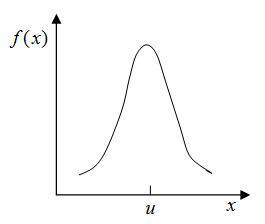

Where, u is the mean and ![]() is the standard deviation.
is the standard deviation.
In OptiStruct RBDO, the normal distribution can be defined as ![]() on the corresponding fields in the DESVAR entry.
on the corresponding fields in the DESVAR entry.
Log-normal Distribution (ITYPE = LOG):
The log-normal distribution is a continuous probability function which approximates the distribution of a random variable whose logarithm is normally distributed. The log-normal distribution is often used in risk analyses.
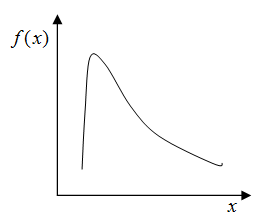

Where, ![]() .
. ![]() is the shape parameter and is also the standard deviation of the log of the distribution;
is the shape parameter and is also the standard deviation of the log of the distribution; ![]() is the location parameter and is the scale parameter and is also the median of the distribution.
is the location parameter and is the scale parameter and is also the median of the distribution.
In OptiStruct RBDO, the log-normal distribution can be defined as ![]() on the corresponding fields in the DESVAR entry.
on the corresponding fields in the DESVAR entry.
Uniform distribution (ITYPE = UNIF):
The uniform distribution is a continuous probability function which approximates the distribution of a random variable between a minimum and maximum when all values are equally likely (such as from a random generator).
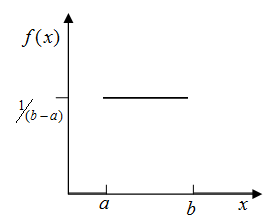

Where, a < b , a and b are end points.
In OptiStruct RBDO, the uniform distribution can be defined as ![]() on the corresponding fields in the DESVAR entry.
on the corresponding fields in the DESVAR entry.
Triangular distribution (ITYPE = TRIA):
The Triangular distribution is used when the only info known is the minimum, the most likely value, and the maximum.
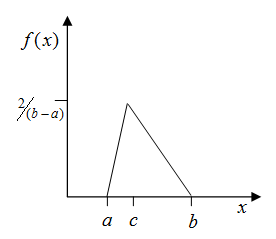
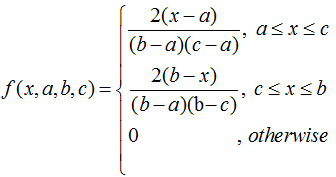
Where, a, b, and c are end points and the mode.
In OptiStruct RBDO, the triangular distribution can be defined as ![]() on the corresponding fields in the DESVAR entry.
on the corresponding fields in the DESVAR entry.
Exponential distribution (ITYPE = EXPO):
The Exponential distribution describes the amount of time between events, and the mean time between failures.
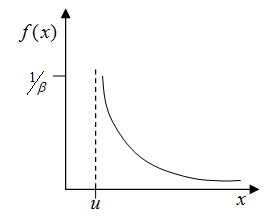

Where, ![]() is the location parameter,
is the location parameter, ![]() is the scale parameter.
is the scale parameter.
In OptiStruct RBDO, the exponential distribution can be defined as ![]() on the corresponding fields in the DESVAR entry.
on the corresponding fields in the DESVAR entry.
Weibull distribution (ITYPE = WEIB):
The Exponential distribution describes the amount of time between events, and the mean time between failures.
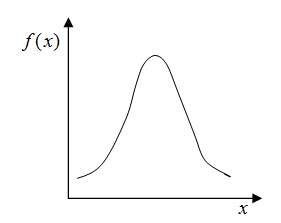

Where, ![]() is the shape parameter; u is the location parameter and
is the shape parameter; u is the location parameter and ![]() is the scale parameter.
is the scale parameter.
In OptiStruct RBDO, the Weibull distribution can be defined as ![]() on the corresponding fields in the DESVAR entry.
on the corresponding fields in the DESVAR entry.
| 5. | Due to the deviation of the random distribution, the design region needs to be defined carefully. For example, if a design variable value is intended to be positive, then its lower bound should not be defined lower than n* |
| 6. | The three distribution parameters, P1, P2, and P3 determine the various distribution curves. As the mean value of the design variable will change during the optimization process, the corresponding distribution parameter will be updated accordingly. This means that the distribution curve moves while the shape does not change. For instance, for Normal Distribution (ITYPE=NORM), the first parameter is the mean and therefore, has no influence on Reliability-based Design Optimization. The DESVAR directly defines the mean value of the random variable/parameter. Therefore, for some distribution types, P1 can be set to 0.0 and OptiStruct will automatically calculate the values. These distribution types include, Normal, Lognormal, Exponential, and Weibull distributions. |
| 7. | This card is represented as an optimization designvariable in HyperMesh |
See Also: